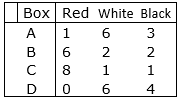Suppose we have four boxes A,B,C,D containing coloured marbles as given below:

One of the boxes has been selected at random and a single marble is drawn from it. If the marble is red, what is the probability that it was drawn form box A? box B? box C?
Let us assume U1, U2, U3, U4 and A be the events as follows:
U1 = choosing Box A
U2 = choosing Box B
U3 = choosing Box C
U4 = choosing Box D
A = choosing red marble from box
We know that each box is most likely to choose. So, probability of choosing a box will be same for every Urn.
⇒ ![]()
⇒ ![]()
⇒ ![]()
⇒ ![]()
The Probability of choosing marble from each box differs from box to box and the probabilities are as follows:
⇒ P(A|U1) = P(Choosing red marble from Box A)
⇒ ![]()
⇒ ![]()
⇒ ![]()
⇒ P(A|U2) = P(Choosing red marble from Box B)
⇒ ![]()
⇒ ![]()
⇒ ![]()
⇒ P(A|U3) = P(Choosing red marble from Box C)
⇒ ![]()
⇒ ![]()
⇒ ![]()
Since there is no red marbles in Box D, the probability of choosing red marble is 0.
i.e, P(A|U4) = 0
Now we find
P(U1|A) = P(The chosen red marble is from Box A)
P(U2|A) = P(The chosen red marble is from Box B)
P(U3|A) = P(The chosen red marble is from Box C)
Using Baye’s theorem:
⇒ ![]()
⇒ ![]()
⇒ ![]()
⇒ ![]()
⇒ ![]()
⇒ ![]()
⇒ ![]()
⇒ ![]()
⇒ ![]()
⇒ ![]()
⇒ ![]()
⇒ ![]()
∴ The required probabilities are ![]() .
.